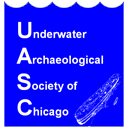The tugboat Tacoma was built in 1894 at Benton Harbor, Michigan, by Edward W. Heath. She was just over 73 feet in length, had an 18 foot beam, and was registered at 76 gross tons. Her official number was 145673. Throughout her thirty-five year career, she served as a dredge tug for Fitzsimmons and Connell Dredge and Dock Company of Chicago.
At 12:30 p.m., on November 4, 1929, the Tacoma was three quarters of as mile south of the 68th Street crib, towing two scows from Chicago to South Chicago when she sprang a large leak. Captain C. Shaoffer had only five minutes to send a distress signal of four blasts on his whistle before the old tug sank. The crew of six barely had time to unleash the towing cable and climb aboard one of the scows before the tug went down. A nearby tug, the Andrew Green, took over the tow of the two scows, and the Tacoma's crew were transferred to the Jackson Park Coast Guard surf boat, which had come to the rescue upon hearing the distress signal.
Later that day, the Jackson Park Coast Guard crew marked the Tacoma's position with a buoy, but it was later decided that she was too old to make raising her worthwhile. At the time of her sinking, the Tacoma was the oldest of the thirty tugs working in Chicago.
As She Rests Today
The Tacoma is Chicago's most intact tug wreck and is a favorite of area divers. The starboard side is somewhat deteriorated, but the majority of the hulk and deck are intact. The large boiler dominates the wreck and sitting atop it is a steam chest. Further aft is the two cylinder steam engine. On the stern deck is the steering quadrant, and on the underside of the hull is the four-bladed propeller and rudder. An opening next to the prop provides access to a limited portion of the interior. The Tacoma's smokestack lies in the sand to the port side.
The Underwater Archaelogical Society of Chicago encourages all divers to visit this shipwreck. Remember! Illinois law prohibits the removal of anything from this or any other historic wreck. Please help preserve our maritime heritage!
Research by Henry Schwenk
Sponsored by a grant from .
